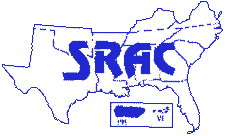 Contact your area USDA-Natural
Resources Conservation Service to
have your site evaluated for vertical
clay and sand content. Ponds
constructed without proper planning
may not hold water or have
adequate access, and may have
persistent weed problems, be difficult
to harvest, and be difficult
to drain completely.
Information in this publication is
based primarily on pond construction
experience in the Delta
region of Mississippi, Arkansas
and Louisiana. Please refer to
SRAC publication no. 102, Watershed
Fish Production Ponds, for
information about constructing
ponds in rolling terrain.
Contact your area USDA-Natural
Resources Conservation Service to
have your site evaluated for vertical
clay and sand content. Ponds
constructed without proper planning
may not hold water or have
adequate access, and may have
persistent weed problems, be difficult
to harvest, and be difficult
to drain completely.
Information in this publication is
based primarily on pond construction
experience in the Delta
region of Mississippi, Arkansas
and Louisiana. Please refer to
SRAC publication no. 102, Watershed
Fish Production Ponds, for
information about constructing
ponds in rolling terrain.
Pond morphology
Commercial catfish ponds are
being built deeper than previously
recommended. Research indicates
and producer opinion confirms
that deeper ponds have longer life
expectancy and allow greater
water conservation. Where possible,
ponds should be built to contain
an average of 5.5 to 6 feet of
water depth. This requires that
average total pond depth with
freeboard be 7 to 7.5 feet.
Minimum water depth in the shallow
area should be 3.5 feet with a
maximum depth near the drain of
8 feet. Ponds should have a minimum
average water depth of 3
feet at all times. A bottom slope of
0.2 to 0.3 feet per 100 linear feet
along the long axis of the pond is
recommended for adequate
drainage.
In recent years, the average size of
newly constructed, commercial
catfish ponds has declined to 8 to
12 acres. As older, larger ponds
(18 to 25 acres) have been renovated,
producers have divided them
into smaller production units. Fish
farmers report that the additional
costs associated with building
smaller ponds are more than offset
by improved feeding efficiencies
and ease of management. A
12-acre land unit should yield 10
acres of water depending on levee
top width and the slope selected
for the inside levee.
Topography and the planned use
for the pond will determine pond
size. Ponds used to produce fry
and fingerlings are typically
smaller than ponds used for food
fish production. A typical layout
of commercial catfish ponds is
shown in Figure 1.
Pond shape is determined by the
boundaries of the production unit
and the access to drainage. Ponds
are typically rectangular and have
a 2:1 to 3:1 ratio of length to
width. While square ponds are
cheaper to construct, rectangular
ponds have the following advantages:
longer levee length for feeding;
lower electrical and piping
costs; and shorter seines needed
for harvesting (Fig. 1). A pond
with a dimension of 500 x 1000
feet will contain approximately 10
acres of water.
Ponds should be as regularly
shaped as possible. Triangular
ponds or ponds with lots of curvature
in the levees can be difficult
to harvest. These ponds are
also more expensive to construct
on a land to water-acre basis. Use
remaining small or irregularly
shaped parcels of land for feed
bins or equipment storage where
possible.
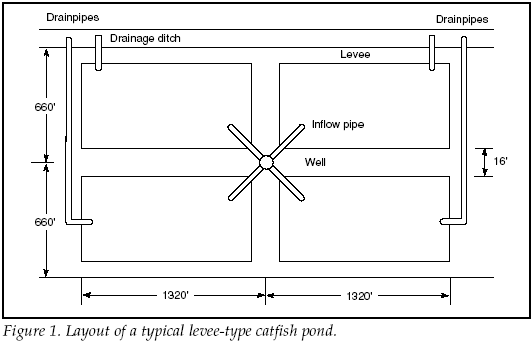
The long axis of rectangular ponds should be parallel to prevailing winds during the peak production period of April through October. Thus, ponds in the southeastern U.S. should be constructed with the long axis running from west-southwest to east-northeast. A north-south orientation of the long axis should be avoided to minimize the erosion caused by winter winds.
Design of levees
Interior levees should have a minimum
top width of 16 feet (20 feet
is preferred so two vehicles can
pass safely). Levees narrower
than 16 feet may become difficult
to traverse and be unusable in 3
to 5 years if there is even the
smallest amount of erosion.
Narrow levees hinder management
and are dangerous at night
and when wet.
Main access levees should have a
minimum top width of 20 feet; 25
feet is preferred. Main levees
must be wider to accommodate
fixed equipment such as wells,
generators, aerators and electrical
panel boxes while permitting passage
of feed delivery and hauling
trucks. Main levees should be
graveled for all-weather access.
Harvesting, feeding and bird control
are often carried out during
wet conditions, making gravel
essential on at least one side of
each pond.
Freeboard is the height of the
levee above the normal water
level. A 1.5-foot freeboard height
is recommended (USDA Natural
Resources Conservation Service)
for a pond 600 to 1,300 feet long.
One foot of freeboard is adequate
if ponds are less than 600 feet
long. Excessive freeboard (more
than 2 feet) makes seining and
placement of emergency aeration
equipment more difficult.
Slope is expressed as the horizontal
distance (in feet) that results in
a 1-foot change in height. Hence, a
3:1 slope extends out 3 feet horizontally
for each foot of height,
and a 4:1 slope extends 4 feet horizontally
for each foot of height
(Fig. 2). The slope selected by the
pond owner will affect construction
costs. Greater slope may
decrease erosion but will also
increase construction costs. For
most soils, an outside levee slope
of 3:1 is preferred. Inside slope
for commercial ponds typically
ranges from 3:1 to 4:1 depending
on owner preference. Slope
greater than 4:1 should be avoided,
as construction costs are
excessive and there are likely to
be more weed problems.
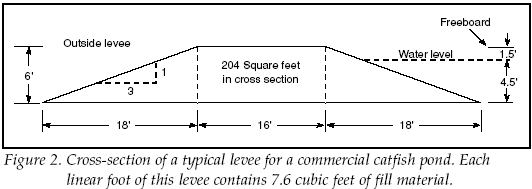
Drainage
A perimeter drainage system
should be constructed to receive
effluents and to prevent water
from standing outside levees.
The existing drainage system
might be modified, or a new
system constructed. Earth
removed during construction of
the drainage ditches can be used
as fill for levees.
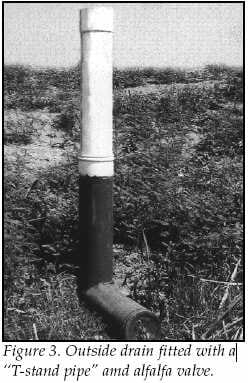 Drains are most often installed
after the levee is constructed by
trenching through the levee with
a backhoe. This ensures proper
placement of the drain and minimizes
the risk of settling, which
can hinder the complete draining
of the pond. A single 10-inchdiameter
drain of heavy gauge,
coated metal or PVC pipe is adequate
to maintain water level and
drain a commercial pond. Because
most soils have high clay content
and most levees are relatively
low, anti-seep collars are not usually
included on the drainpipe.
Drains are most often installed
after the levee is constructed by
trenching through the levee with
a backhoe. This ensures proper
placement of the drain and minimizes
the risk of settling, which
can hinder the complete draining
of the pond. A single 10-inchdiameter
drain of heavy gauge,
coated metal or PVC pipe is adequate
to maintain water level and
drain a commercial pond. Because
most soils have high clay content
and most levees are relatively
low, anti-seep collars are not usually
included on the drainpipe.
The drain should extend into the
pond and past the outside levee
toe by at least 5 feet. A 1-inch
drop in the pipe to the levee toe
will ensure complete drainage of
the pipe when the pond is dry.
The inside (pond side) drain end
is capped with an expanded metal
screen (0.5-inch mesh) 3 to 4 feet
long to keep fish from entering
the drain. If the pipe does not
extend properly outside the pond,
severe levee erosion is likely to
occur when overflow or drain
water is released. The outside end
is fitted with a T standpipe to
set the desired pond level and
capped at the end with an alfalfa
valve (Fig. 3).
The length of the
plastic terminal sleeve (or jam
pipe or riser) can be altered to
adjust the water level in the pond.
Other drain types such as swivel
pipes and concrete monks can
be installed in commercial ponds
but are not recommended because
they cost more and have limited
usefulness. The area immediately
surrounding the interior drain
(25-foot-radius) should be slightly
deeper (3 to 4 inches) than the rest
of the pond so that the pond
drains fully. Any fish remaining at
drawdown will be concentrated in
this area.
Site preparation and construction
All vegetation, roots and stumps
must be removed before levees
are constructed. The top 2 to 3
inches of surface soil can be
removed and reserved for placement
on outside levee slopes so
that any recent pesticide residues
are excluded from the pond. This
soil will also be more conducive
to establishing vegetative cover.
Dirt pans are the primary implements
recommended for commercial
levee construction. They cost
less to use and compact the soil
better than other implements. Dirt
pans lay down a thin layer of soil
with each pass and pack the previously
applied soil layer. Bulldozers
are the primary implements
used in pond renovation
(see SRAC publication no. 104).
For proper compaction, soil moisture
content should be 12 to 15
percent. Moisture levels higher or
lower than this can make soil
compaction difficult. Levees built
from heavy clay soils (more than
30 percent) following these guidelines
should have a useful life of
10 years or more.
Where groundwater is relatively
abundant, wells are the preferred
water source because groundwater
is free of undesirable fish and
contaminants. A well output of
1,000 gallons per minute is considered
adequate to fill and maintain
40 water acres (25 gallons per
minute per water acre). The well
can be drilled either before or
after construction. Well placement
should be as close as possible to
minimize the amount of pipe
required. Lengthy pipe installations
cost more to construct and
repair, and yield less water
because of frictional forces. The
distance from the wellhead to the
farthest discharge point should be
less than 1,500 feet in any direction.
Well pipes are buried in the
ground to permit traffic on levee
tops. Filling ponds by connecting
pipes pond to pond is not recommended
because it takes longer to
fill connected ponds and disease
and trash fish can be transferred
from one pond to another.
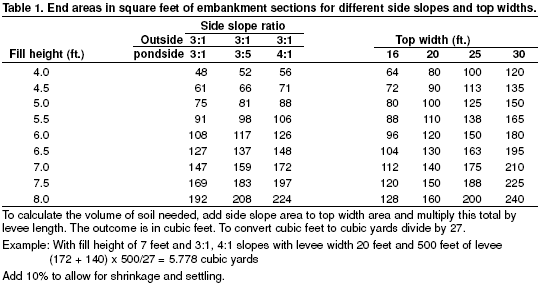
As soon as pond construction is completed, a vegetative cover should be established on the levees to control erosion. Winter annuals such as rye or wheat or perennial forages such as bermudagrass make good cover and will exclude most volunteer grasses and weeds that provide poor coverage. If construction is completed and wheat or rye grass planted in the fall, it should be replaced with bermudagrass or another effective low cover in the spring. Establishing proper cover is cost-effective because it prevents excessive erosion, reduces mowing costs, and allows allweather access to ponds. For information on the best ground covers for your location, consult your state Extension service Web site for publications or contact your county Extension agent.
References
PondsPlanning Design, Construction United States Department of Agriculture/Natural Resources Conservation Service, Agriculture Handbook Number 50, Revised 1997, U.S. Department of Agriculture, Washington, D.C. 20250.
Commercial Fishponds, United States Department of Agriculture/Natural Resources Conservation Service,
Conservation Practice Standard, Field Office Technical Guide, Section IV, Revised 2000, U.S. Department of Agriculture, Washington, D.C. 20250
Source: Southern Regional Agricultural Center and the Texas Aquaculture Extension Service - May 2002


